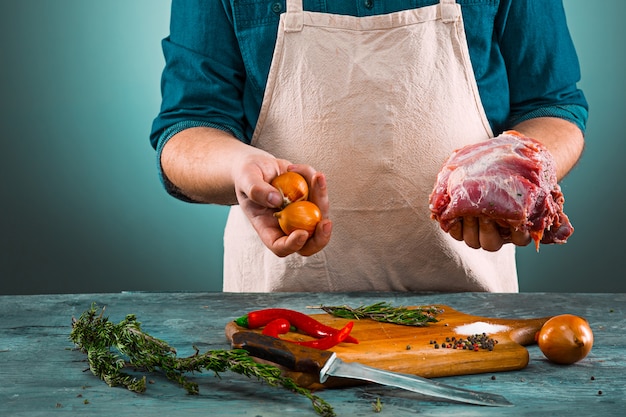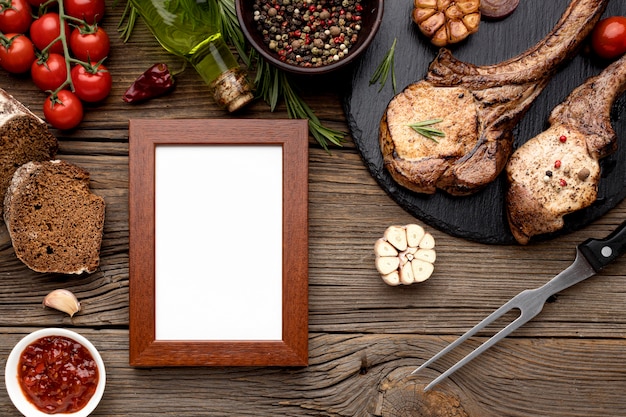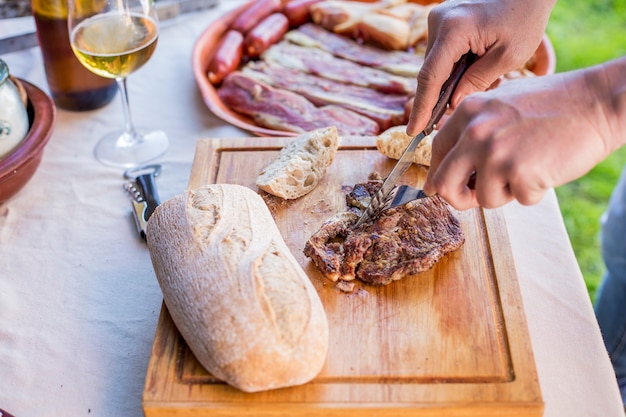Lamb, with its rich flavour and tender texture, is a real treat. But getting it just right can be a bit of a culinary challenge. Overcooked lamb becomes dry and tough, while undercooked lamb can be a bit of a gamble. I've definitely had my fair share of lamb mishaps, like the time I tried to impress my in-laws with a roast lamb, only to serve it up dry as a bone. It wasn’t exactly a recipe for success, and the awkward silence at the dinner table spoke volumes! But I've learned from my mistakes, and I'm here to help you avoid them.
This guide is your passport to mastering the art of cooking lamb. It's all about understanding the different cuts, their cooking times, and how to achieve the perfect level of doneness. Whether you're a seasoned chef or a kitchen novice, this guide will equip you with the confidence to cook delicious lamb dishes that will impress even the most discerning palate. So, let's get started!
(Part 1) Unveiling the Secrets of lamb cuts

The journey to perfect lamb begins with understanding the different cuts and their unique characteristics. Each cut has a distinct flavour profile and tenderness, and choosing the right one will determine the best cooking method and timing.
1.1 The Shoulder (or Neck): A budget-friendly Gem
The shoulder, also known as the neck, is a fantastic option for those on a budget. It's a cut that's packed with flavour and perfect for slow cooking methods like braising or roasting. The shoulder boasts a generous amount of connective tissue, which transforms into tender, melt-in-your-mouth goodness during long, slow cooking. Think of it as a culinary treasure waiting to be unearthed with time and patience.
1.2 The Leg: A Versatile Classic
The leg of lamb, a classic favourite, is a lean cut with a good amount of fat marbling, making it ideal for roasting. It's a versatile cut that can be roasted whole for a grand feast or sliced into chops for a more casual meal. The leg is often seasoned with aromatic herbs like rosemary and thyme, and it pairs beautifully with roasted vegetables.
1.3 The Loin: A Luxurious Choice
The loin is the most tender and flavorful cut of lamb, making it a luxurious choice for special occasions. It's often found as boneless loin chops, which are incredibly versatile and can be grilled, roasted, or pan-fried. The loin's rich flavour and tender texture make it a real crowd-pleaser.
1.4 The Rack: A Show-Stopping Cut
The rack, with its beautiful rib bones, is a truly show-stopping cut. It's boneless and includes the ribs, making it ideal for roasting, grilling, or even pan-frying. The rack's impressive presentation makes it a perfect choice for a celebratory meal.
1.5 The Breast: A Hidden Treasure
The breast, a smaller, more flavorful cut, is often found as part of the shoulder. It's a versatile cut that can be roasted, grilled, or braised. The breast's compact size makes it a perfect option for individual servings or smaller gatherings.
(Part 2) Cooking Methods for Every Occasion

Now that you've chosen your perfect cut of lamb, it's time to select a cooking method that will bring out its best flavour. Each cooking method creates a distinct texture and flavour profile.
2.1 Roasting: A Classic with Timeless Charm
Roasting, a classic cooking method, is a fantastic option for larger cuts of lamb like the leg or shoulder. It allows the fat to render, creating a juicy and flavorful roast. The gentle heat of the oven allows the lamb to cook evenly, creating a beautifully browned exterior and a tender, succulent interior.
2.2 Grilling: Bringing the Smoke and Sizzle
Grilling, with its smoky allure, is a great way to cook smaller cuts like chops or the loin. The high heat of the grill creates a delicious char and adds a smoky flavour that's simply irresistible. Grilling is a perfect choice for warm weather gatherings, creating an outdoor feast that's both delicious and convivial.
2.3 Braising: Transforming Tough Cuts into Tender Delights
Braising, a method that combines searing and slow simmering, is a perfect solution for tougher cuts like the shoulder or shank. Searing the meat first creates a flavorful crust, while simmering in liquid tenderises the tough connective tissue, transforming it into melt-in-your-mouth perfection. Braising is a method that requires patience, but the result is incredibly rewarding, creating a rich, aromatic dish that's perfect for a cozy winter meal.
2.4 Pan-Frying: Quick and Easy Elegance
Pan-frying is a quick and easy way to cook lamb chops or smaller cuts. It requires a hot pan and a little bit of oil to create a crispy crust and lock in the juices. Pan-frying is a versatile method that can be used to create simple weeknight meals or impressive dinner parties.
2.5 Slow Cooking: Unleashing the Magic of Time
Slow cooking, a method that uses low and slow heat, is a perfect way to cook tougher cuts like the shoulder. It allows the meat to cook slowly in its own juices, resulting in a melt-in-your-mouth texture and a rich, flavourful broth. Slow cooking is a perfect way to create a delicious meal without spending hours in the kitchen. Simply throw your ingredients into the slow cooker and let it work its magic while you go about your day.
(Part 3) Mastering the Art of Lamb Cooking Times

Now that we've explored the different cuts and cooking methods, it's time to delve into the heart of the matter: cooking times. The exact time will vary depending on the size and thickness of the cut, the cooking method, and your desired level of doneness.
3.1 Roasting: A Guide for Every Occasion
Here's a general guide for roasting lamb, keeping in mind that these are just estimates. The best way to ensure your lamb is cooked to your liking is to check the internal temperature with a meat thermometer.
| Cut | Weight (kg) | Cooking Time (minutes per kg) |
|---|---|---|
| Leg | 1.5-2.5 | 20-25 |
| Shoulder | 1.5-2.5 | 25-30 |
| Rack | 0.5-1.0 | 15-20 |
3.2 Grilling: Bringing the Heat
For grilling, you'll want to cook lamb chops or thinner cuts over medium heat. Aim for about 3-5 minutes per side, depending on the thickness. A good rule of thumb is to sear the lamb first to create a crispy crust, then reduce the heat and continue cooking until it reaches your desired level of doneness.
3.3 Braising: Patience Rewarded
Braising times can vary greatly depending on the cut of lamb and the recipe. A general guideline is to braise lamb for 2-3 hours, but it may take longer for tougher cuts. The key is to ensure the meat is tender and the liquid has reduced to a rich, flavorful sauce.
3.4 Pan-Frying: Quick and Delicious
Lamb chops or smaller cuts typically take about 3-5 minutes per side when pan-fried. The goal is to create a crispy crust while keeping the interior juicy and tender. A hot pan and a little bit of oil are essential for successful pan-frying.
3.5 Slow Cooking: A Culinary Symphony of Time
Slow cooking times for lamb can range from 6 to 8 hours on low, or 3 to 4 hours on high. The low and slow heat allows the connective tissue to break down, resulting in incredibly tender and flavorful lamb. Slow cooking is a perfect way to create a hands-off meal that's both delicious and comforting.
(Part 4) Temperature Matters: The Key to Perfect Doneness
To ensure your lamb is cooked to your liking, it's essential to check the internal temperature with a meat thermometer. The exact temperature will depend on your preference for doneness, but a safe internal temperature for lamb is above 145°F (63°C). Here's a guide to different levels of doneness:
- Rare: 125°F (52°C)
- Medium-Rare: 130°F (54°C)
- Medium: 140°F (60°C)
- Well-Done: 150°F (65°C)
Personally, I prefer my lamb medium-rare, but it's all about your taste. Just remember to always ensure the internal temperature is above 145°F (63°C) to guarantee food safety.
(Part 5) Resting Your Lamb: A Culinary Patience Game
Once your lamb is cooked, it's crucial to let it rest for 10-15 minutes before carving. This step, often overlooked, is essential for a tender and juicy result. Resting allows the juices to redistribute throughout the meat, preventing them from running out when you carve.
To rest your lamb, cover it loosely with foil and let it sit on a cutting board. Resist the urge to carve it immediately, as this will lead to a drier, less flavorful cut.
(Part 6) Unleashing the Flavors: Seasoning Your Lamb
Seasoning your lamb properly is a culinary art form. It's about enhancing its natural flavour and creating a symphony of taste. Here are a few of my favourite seasoning combinations, but don't be afraid to experiment and discover your own signature blends:
6.1 Mediterranean Lamb: A Taste of Sunshine
This classic combination features fresh herbs, garlic, and lemon juice, creating a bright and refreshing flavour that's perfect for warm weather. Simply rub your lamb with a mixture of olive oil, chopped rosemary, thyme, oregano, garlic, and lemon juice. This flavourful blend adds a touch of Mediterranean sunshine to your plate.
6.2 Herbed Garlic Lamb: A Simple Delight
This simple yet effective seasoning combines the fresh aromas of herbs with the robust flavour of garlic for a burst of flavour. Combine chopped rosemary, thyme, parsley, garlic, and salt and pepper for a classic seasoning that complements the natural flavour of the lamb.
6.3 Moroccan Lamb: A Spicy Adventure
This exotic seasoning takes you on a culinary journey to Morocco, combining sweet and savoury flavours for a truly unique dish. You'll need a mix of cumin, coriander, paprika, turmeric, cinnamon, and ginger. These spices create a complex and aromatic blend that's both warming and exotic.
(Part 7) Tips for Lamb Cooking: A Guide to Culinary Success
Here are a few tips to help you cook lamb like a pro:
- Embrace the Meat Thermometer: The most reliable way to ensure your lamb is cooked to your liking is to use a meat thermometer. It's a small investment that can save you from overcooked or undercooked lamb, leading to a far more enjoyable dining experience.
- Pat It Dry: Before cooking, pat the lamb dry with paper towels. This simple step helps the lamb to brown nicely and develop a crispy crust, adding a delightful texture and flavour to your dish.
- Searing is Key: For most cooking methods, you should sear the lamb in a hot pan or over high heat. This creates a flavorful crust and locks in the juices, ensuring the lamb remains moist and tender. Searing is a crucial step for unlocking the full flavour potential of your lamb.
- Avoid Overcooking: Lamb is a delicate meat, so it's easy to overcook it. Pay close attention to the cooking times and check the internal temperature regularly. Overcooked lamb can become dry and tough, so it's best to err on the side of caution.
- Rest and Relax: Resting the lamb after cooking is crucial for a tender and juicy result. It allows the juices to redistribute throughout the meat, creating a more flavorful and enjoyable dining experience.
(Part 8) Serving Your Lamb: A Culinary Celebration
When serving your lamb, carve it across the grain for the most tender results.
Lamb pairs beautifully with a variety of sides. Here are a few classic combinations that will elevate your meal:
- Roasted Vegetables: Roasted vegetables, with their caramelized sweetness, complement the rich flavour of lamb perfectly. Think carrots, parsnips, and potatoes for a hearty combination.
- mashed potatoes: creamy mashed potatoes provide a comforting and indulgent side for lamb. They soak up the flavorful juices, creating a truly satisfying meal.
- green beans: Steamed or sauteed green beans add a fresh and vibrant touch to your lamb dish. Their bright green colour contrasts beautifully with the rich brown of the lamb, creating a visually appealing plate.
- Couscous: Fluffy couscous, with its light and airy texture, is a perfect accompaniment to lamb, especially when infused with aromatic spices and herbs.
- rice pilaf: A fragrant rice pilaf, studded with herbs and spices, provides a comforting and flavorful base for your lamb dish.
Don't forget to add a delicious sauce to your lamb. These sauces are perfect for enhancing the flavour of your lamb and completing your culinary masterpiece:
- Mint Sauce: This classic sauce, with its refreshing flavour, is a perfect pairing for lamb. It cuts through the richness of the lamb, creating a harmonious balance of flavours.
- Red Wine Sauce: A rich and flavorful red wine sauce adds depth and complexity to your lamb dish. It's a perfect choice for a special occasion meal.
- Gravy: A simple gravy, made from the pan drippings, adds a rich and savoury flavour to your lamb. It's a classic accompaniment that's both comforting and delicious.
- Lemon and Herb Sauce: A bright and zesty lemon and herb sauce adds a fresh and vibrant touch to your lamb dish. It's a perfect choice for a lighter meal.
If you're feeling adventurous, you can also try a Moroccan tagine or a Greek moussaka. These dishes showcase the versatility of lamb and offer a unique culinary experience. Embrace your inner chef and explore the world of lamb cuisine!
FAQs: Unlocking Your Culinary Curiosity
Here are some frequently asked questions about lamb cooking:
1. How do I know if my lamb is cooked through?
The most reliable way to check if your lamb is cooked through is to use a meat thermometer. Insert the thermometer into the thickest part of the meat, avoiding bone, and check the internal temperature. Always ensure the internal temperature is above 145°F (63°C) for food safety.
2. Can I cook lamb in the oven at a lower temperature?
Yes, you can cook lamb at a lower temperature, but it will take longer. For example, you can cook lamb at 300°F (150°C) for about 20 minutes per pound. The slower cooking time allows the lamb to cook more evenly and results in a tender and flavorful roast.
3. Can I freeze lamb?
Yes, you can freeze lamb. It's best to freeze it in airtight containers or freezer bags, labelled with the date. Lamb can be frozen for up to 3 months. When thawing frozen lamb, it's best to do so in the refrigerator for a few days, allowing it to thaw slowly and evenly.
4. What are some good lamb recipes?
There are countless delicious lamb recipes out there! Here are a few popular options to inspire your culinary journey:
- Roast Leg of Lamb with Mint Sauce: A classic and elegant dish that's perfect for a special occasion meal. The mint sauce adds a refreshing and vibrant touch to the rich flavour of the lamb.
- grilled lamb chops with Rosemary and Garlic: A simple and flavorful dish that's perfect for a weeknight meal. The rosemary and garlic add a delicious aroma and flavour to the grilled lamb chops.
- Lamb Tagine with Apricots and Almonds: A fragrant and exotic dish that's perfect for a flavourful adventure. The sweet apricots and crunchy almonds complement the rich flavour of the lamb, creating a truly unique culinary experience.
- slow cooker lamb Curry: A comforting and delicious dish that's perfect for a cold winter night. The slow cooking process allows the lamb to become incredibly tender and flavorful, while the curry sauce adds a warming and comforting touch.
5. Can I eat lamb if I’m pregnant?
It's generally safe to eat lamb while pregnant, but it's best to make sure it's cooked thoroughly to an internal temperature of at least 145°F (63°C). This will help to kill any harmful bacteria. If you're unsure, always consult with your doctor or midwife for advice on food safety during pregnancy.
There you have it. The ultimate guide to cooking lamb! It may seem daunting at first, but with a little practice and some patience, you'll be able to cook delicious lamb dishes that will impress your family and friends. So, go forth, embrace your inner chef, and create culinary masterpieces that will leave everyone wanting more!
Everyone is watching

Corn on the Cob: The Ultimate Guide to Perfectly Cooked Ears
Healthy MealsAh, corn on the cob. Just the name evokes images of sunny days, barbecues, and that sweet, juicy flavour that ...

Scallops: The Ultimate Guide to Perfect Cooking
Healthy MealsAh, scallops. Those delicate, sweet, and utterly delicious morsels of the sea. They hold a special place in my...

Spaghetti Squash: The Ultimate Guide to Cooking and Serving
Healthy MealsRemember that time you saw spaghetti squash at the supermarket, looking all bumpy and strange, and thought, "W...

Salmon Cooking Times: Perfect Guide for Every Recipe
Healthy MealsLet me tell you, cooking salmon is an art form. It's all about getting that perfect balance: juicy and tender,...

Ham Cooking Time: How Long to Bake, Smoke, or Boil a Delicious Ham
Healthy MealsAh, ham. It's a classic, isn't it? A real crowd-pleaser, especially around holidays. And when done right, it'...
